Walkabout (1971)
Directed by: Nicolas Roeg
Written by: Edward Bond, James Vance Marshall, Nicolas Roeg
Starring: David Gulpilil, Jenny Agutter, John Meillon, Luc Roeg
UK/AUSTRALIA
AVAILABLE ON BLU-RAY: 31ST AUGUST, from SECOND SIGHT
RUNNING TIME: 100 mins
REVIEWED BY: Dr Lenera
A man drives his teenage daughter and younger son into the Australian outback, ostensibly for a picnic. However, the father, clearly having a mental breakdown, starts shooting at the children, whereupon they flee and he sets the car on fire, then shoots himself in the head. The girl conceals the suicide from her brother and leads him away from the scene, attempting to walk home. However, they’re lost, getting weak, and the only spot of water they find quickly dries up. An Aboriginal boy comes across them and the three begin to travel together despite communication being a problem….
It begins with a husband leaving his office job and heading through busy city streets for his condominium home that overlooks a swimming pool while his wife is cooking dinner. It ends with another, considerably happier, husband leaving his office job and heading through busy city streets for his condominium home that overlooks a swimming pool while his wife is cooking dinner. The camera, and its principal characters, transition into the desert by tracking along a wall that suddenly stops, and, near the end of the film, the end of the wilderness is shown when the camera pans along part of a hill which ends and we can see ‘civilisation’ lying before them. The desert adventure begins and closes with a suicide, the first by someone we’ve hardly got to know, the second by someone we’ve certainly got to know. The plot is almost as simple as can be; two children are stranded in the desert and encounter an Aboriginal youth who will, hopefully, lead them to safety. And yet Walkabout can be enjoyed on both a simple and an intellectual level. Its themes are plentiful and looked at in a sober, balanced fashion. If you want food for thought, we’re asked to consider the clashing of cultures, sexual awakening, human communication, the way we’re conditioned to function in our environment but not outside of it, and many other things. Despite being structured largely as a series of montages with director/cinematographer Nicolas Roeg, in his first solo film as director already showcasing his mastery of film grammar and willingness to experiment with it, this deeply tragic work is one that gets more thought provoking and moving each time you see it.
Roeg first wanted to film James Vance Marshall’s 1959 novel in 1966 with Jenny Agutter already his pick for the female lead, but couldn’t get any interest so he made Performance instead with Donald Cammell. Then playwright Edward Bond did a 14-page treatment which tweaked events and sexualised the novel which I remember reading at school. Roeg expanded this into 67 pages, then obtained backing from two American businessmen, Max Raab and Si Litvinoff, who incorporated a company in Australia but raised the budget entirely in the US and sold world rights to 20th Century Fox. Filming took place in Sydney and in and around Alice Springs. Luc Roeg, who played ‘White Boy’, was Nicolas Roeg’s son and replaced his older brother Nico in the role because Nico was too old when filming finally commenced. He was sun-burnt for real in the scene where ‘Black Boy’ treats his back by rubbing him with fat from a wild boar. Roeg suddenly thought it would make a good scene so he filmed it, and elsewhere some improvisation and usage of what was around took place. Not released for two years which raised some confusion about Agutter’s age when she made it [she was 16 despite playing a 14-year old], box office was poor and reviews mixed. Five minutes of nudity and a scene involving a prostitute was cut in the US to attain a ‘GP’ [PG] rating, while in the UK the BBFC asked for said nudity to be removed for an ‘AA’ [14 years and over], but after an appeal by the filmmakers, the film went out uncut, though said prostitute scene remained missing from some versions including the one shown on UK TV. Rights issues caused it to be unavailable for more than a decade, something which unsurprisingly increased its status.
The title refers to a rite of passage which some [though not as many as the opening text, inserted against Roeg’s wishes, suggests] male adolescent Australian Aborigines undergo; to survive for six months in the outback, depending on their skills at hunting, trapping and finding water to survive. But we begin in a bustling city, the opening montage already suggesting just subtly that this ‘civilised’ existence has an emptiness about it, and that we’re watching a family that has something wrong with it, something symbolised by a bug that belongs outdoors but is somehow inside the house. Out in the desert, the father seems to look at his daughter in a not-entirely healthy way when he takes her and the boy [let’s call the two main male characters ‘the Boy’ and ‘the Aboriginal Boy’ rather than ‘White Boy’ and ‘Black Boy’ which they’re called in the credits] out for a picnic. He goes berserk and the Girl and the Boy barely escape with their lives, with the Boy not at all understanding what’s happening. I must already praise the totally naturalistic acting of young Luc Roeg, and the more studied but still very impressive acting of Jenny Agutter, in her first movie starring role [The Railway Children was made after though released before]; the two share an incredible chemistry. Their characters finally fall asleep and when they wake up head in a direction the Girl presumably thinks is most likely towards home. For the last few minutes, the camera’s been close to them, but, as they scale a huge rock, it finally zooms out to show just how in the middle of nowhere they are.
Indeed the environment is another character, from the frequently changing habitats to the plentiful cutaways to its other inhabitants. The amount of the latter may seem rather excessive to some, but these shots are there for a reason. Most of the time these creatures are shown eating, which is a major theme throughout, the nature of consumption perhaps shown most powerfully in a scene where the Aboriginal Boy wrestles a water buffalo he intends he and the Girl and the Boy to eat to the ground, when some white hunters nearly run him over in their truck and proceed to decimate the herd of buffalo with their bullets. The Girl and the Boy encounter the Aboriginal Boy when they really seem to be in trouble out in the desert. The Girl keeps on asking him for water even though it’s patently obvious that he doesn’t have a clue what she’s on about. However, the Boy makes drinking actions and immediately the Aboriginal Boy understands, reminding us how easily kids can cut to the heart of something and how there are things that we lose as well as gain as we get older. As their trek progresses, the Boy and the Aboriginal Boy form a bond, but the Girl remains reserved; occasionally she seems able to cut loose, but she seems to see the Aboriginal Boy as a curiosity more than anything else, albeit a curiosity she’s not that curious about. Possibly institutional racism plays a part, but to me it’s more that the Girl has been conditioned not to show much interest in anything that’s outside her culture. Yet the subject of racism does bring me to one particular scene that speaks volumes without turning into preaching, and it’s the one that was missing from some versions. We see genuinely upsetting images of Aboriginals, including children, making figures of Aboriginals and kangaroos to be sold to tourists while their white boss mocks them. What a horrid degradation of a race.
The Aboriginal Boy develops an interest in the Girl, even though he doesn’t think to step outside the rituals of his culture in pursuing the female he fancies. But at least he tries to reach out. While there’s no actual sex like in many of his other films, Roeg still indulges his interest in the subject; even the first sight of the Girl doing a breathing ritual in class looks a bit sexual, even parts of a tree are photographed to look sexual. At one point we briefly detour into an amusing Federico Fellini-style vignette involving a group of scientists out in the desert who include one female all the guys seems to lust after. I don’t think that the scene is out of place; rather, it’s used to contrast with the main story line, how the Aboriginal Boy has his own, and actually far more respectful, form of courtship. However, the also much-censored nude swim by the Girl is not in my view a sexual sequence. It’s just a celebration of freedom, away from the constraints of the world the Girl was brought up in, and importantly it’s contrasted with hardly pleasant shots of the Aboriginal Boy killing animals for their survival. Indeed one of the most surprising things about Walkabout is that, while modern city life is undeniably considered soulless and having gone too far away from nature, the life the Aboriginal Boy is hardly glamourised; note, for example, the way our our attention is sometimes drawn to the flies buzzing around him.
This was the first film of David Gulpilil [probably most recognisable from the Crocodile Dundee films], though you’d never believe it considering his nuanced performing. Look out for a scene near the end where he says “water”? His character is both disappointed and insulted, yet is too proud to show this too much. Considering that at the time he spoke and understood little English, his delivery and expression is incredible. That’s evidence of instinctual acting skill. Roeg employs a variety of cinematic devices from freeze frames to images of pages of a newspaper superimposed on the screen to tell his tale and enhance his themes. He plays with time and space. Visual connections are continually made, some of which jar at first but make more sense later. The Boy even has a vision of explorers on camels hundreds of years before. Some first-time viewers may find some of this distracting, drawing too much attention to itself, but then this film was released in a decade which, in its first half at least, was the boldest in cinema history, where such experimentation became quite common for a while, where it felt as if the nature of cinema was being taken further than ever before. Collages of sound assault the ear and confuse the mind, yet the music score by John Barry is a work of great beauty, and is vitally important to the experience and effect of this film, along with a bit of Stockhausen. The score helps to bind the montages together and musically evokes the states of the protagonists and their journey on several occasions, while the main theme is one of his very best from this master melodist; very hypnotic, suggesting regret and longing without being too explicit about it.
It’s the deep sadness that leaves the most lasting impression without turning into sentimentality, and not just of two people who in any just world probably belong together as at least ‘friends. We’re also asked to think of the way we all are, and how downright unrealistic it is that the Girl and the Boy totally embrace the ‘back to nature’ lifestyle that the Aboriginal Boy seemingly leads, or the Aboriginal Boy gets ‘educated’ about their world of high rises and radios. One can imagine a Hollywood version of this tale, and then cringe. Right at the end, we get a flashback, with one character seemingly remembering something, yet a second viewing of the film reveals that it’s not actually a ‘proper’ flashback, because what we’re seeing did not really happen. Instead, the person ‘remembering’ is either submitting to that dreadful thing that we all do of rose-tinting our memories, or musing on what should have been. What a wonderful, magical, deep and poignant film Walkabout is.
Rating: 









SPECIAL FEATURES
Brand new 4k scan and restoration
For some reason I never bought Criterion’s Region ‘A’ Blu-ray of this, but do still own their earlier DVD release, which looked rather muddy in places even at the time. I’d imagine that the Criterion Blu-ray restoration is a massive leap forward, but that Second Sight’s presentation is even better. Walkabout is actually quite a difficult and delicate film, with its large amount of natural lighting and employment of different film stocks in places. Often the image seems to be totally intended to be soft, and sharpening things too much would be the wrong thing to do. This new restoration manages to get the balance just about right; the odd flicker is no doubt inherited and I probably only noticed them because, perhaps unfortunately, being a film and disc reviewer makes one tend to do so.
A new audio commentary with Luc Roeg and David Thompson
The Criterion DVD had a commentary from Roeg and Agutter which was excellent, meaning that I’ll probably hold on to my copy. The Criterion Blu-ray added two interviews and a documentary about Gulpilil. Second Sight were presumably unable to port these over, but they’ve been able to provide a good selection of special features of their own to replace them so I don’t think that anyone should feel short changed. The new audio commentary is just as good; Thompson is typically intelligent and makes sure he asks Luc the right questions when the latter starts to run out of things to say. There’s some but not that much digging into themes but we get some interesting information on the authorship of the book, the pointing out of a scene which Nico was originally in, and some recollections such as the film being shot chronologically, though he doesn’t remember his dad’s story about putting him not just on the edge of a cliff but atop a chair because he couldn’t be seen by the camera which was some distance away. Thompson clearly admires the hell out of the film while Luc is proud of it and recalls making it with fondness. A genuinely warm track.
Producing Walkabout: a new interview with Producer Si Litvinoff [10 mins]
Litvinoff, who begins by saying that Walkabout is the greatest film he was involved with [I agree], goes heavily into the production process, with some nuggets that were new to me, such as the project being initially set up without him with Richard Lester to be the director, and Litvinoff initially wanting Roeg to direct A Clockwork Orange.
Luc’s Walkabout: a new interview with Luc Roeg [11 mins]
Luc repeats some of the stuff from the audio commentary, though we also learn that the un-subtitled Aboriginal dialogue that Gulpilil speaks was just stuff Gulpilil was asked to make up, and how there was so much down time due to extensive traveling between locations.
Jenny in the Outback: a new interview with Jenny Agutter [20 mins]
I always have time for Agutter; aside from being a major ‘pin-up’ for me once upon a time, she just seems like a lovely and bright person. She fits in quite a lot into 19 minutes, from what the film’s major meaning is to her to the filming where – due to her age – she was treated as both a child and an adult, and how some crew members disappeared mysteriously.
Remembering Roeg: a new interview with Danny Boyle [19 mins]
Boyle, of course a very fine film-maker himself, begins his appreciation of Roeg and then Walkabout itself by stating that he thinks Roeg as the best British filmmaker and compares him to Picasso. Brave words maybe, but he’s willing to back them up, and I agree that in his most creative period he was incredible, even if I don’t rate Eureka as highly as he does. He comments on Roeg’s use of pop stars, his elliptical editing and great use of the zoom lens which tends to be something directors are against, and other things. I love hearing directors talk about other directors and I just love Boyle’s words here.
2011 BFI Q&A with Nicolas Roeg, Jenny Agutter and Luc Roeg [16 mins]
This chiefly covers ground we’ve already trodden on in the course of going through the special features, and seems to end suddenly as if not all of it was filmed, but it’s nice to actually see Roeg in person.
Archive introduction by Nicolas Roeg
I couldn’t find what this hails from, but it was obviously on an earlier release of the film. Roeg briefly talks about the development of the script.
English SDH subtitles for the hearing impaired
LIMITED EDITION CONTENTS
Limited Edition Box Set of only 3,000
Rigid slipcase with new artwork by Michael Boland
The source novel ‘Walkabout’ with cover artwork excusive to this release
Soft cover book featuring facsimile copy of the original 65 page First Draft Script with preface by Daniel Bird
Soft cover book with new essays by Sophie Monks Kaufman, Simon Abrams and Daniel Bird plus stills and lobby card images
A genuinely great movie that gets better with age gets a very fine release. Highly Recommended.

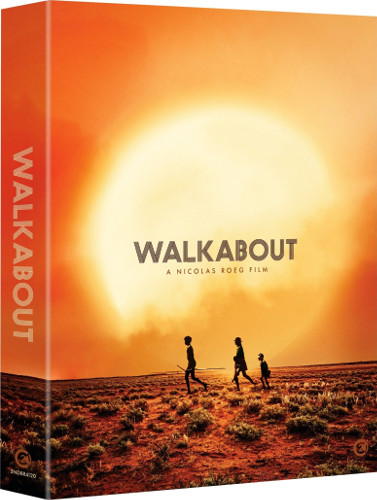
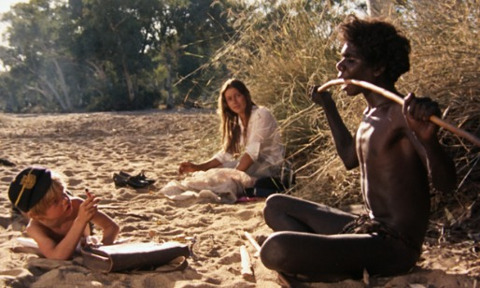
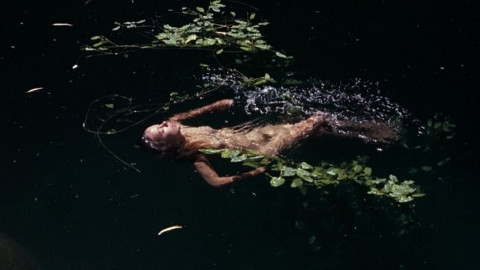

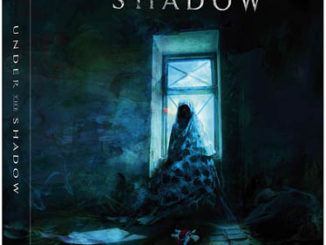
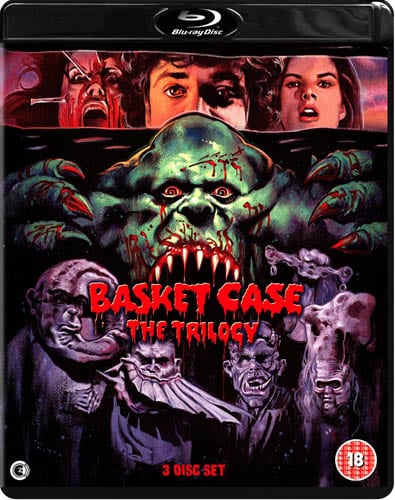
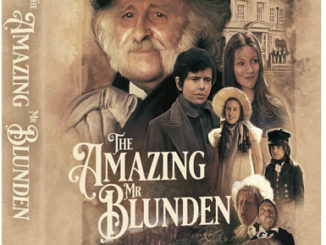
Be the first to comment